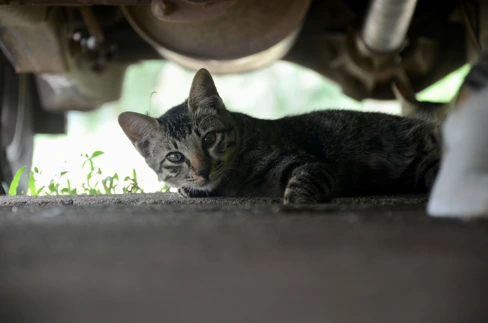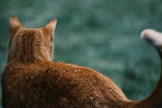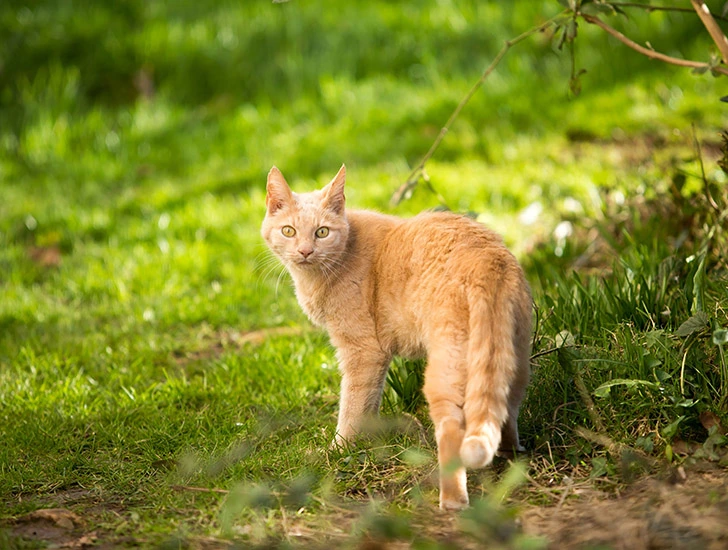Is your cat ready for the great outdoors? Your garden is likely be a great place for your cat to get fresh air, stimulation and exercise, but knowing about potential dangers can help you keep your pet safe. Here's our guide to keeping them safe outside.

Cats that are unfamiliar with their surroundings can get lost. Even in familiar territory, cats may wander too far and may get too confused to find their way home. This is why we recommend microchipping as the best way of identifying your cat and your best hope of being reunited with your lost cat.
Collars may be helpful at identifying your cat, although they often come loose - or get snagged when your cat is exploring or climbing, which could harm your cat. If you decide to fit a collar, choose one with a quick release or snap opening. This will be less likely to trap your cat if they get snagged. Make sure the size is correct. You should be able to fit two fingers snugly underneath it when the cat is wearing it. Cats can catch their leg or jaw in an elasticated or ill-fitting collar.
See also: Microchipping
Cats can be injured through contact with other cats, dogs and humans. Neutering may reduce aggression, but cat fights can still occur, especially when new cats move into the area. Cats will often 'time share' territory, with two cats sharing the same territory at different times of the day. Vaccination is important for any cat going outside as they can easily pick up diseases through contact - or fighting - with other animals.
Worried that your cat is being intimidated by another cat in the garden? Read our feature from Cats Protection's behaviourist on how to prevent cat conflict.
Whether you’re relocating or getting a new cat, as a guide you should keep your cat indoors for three to four weeks before letting them out, but this will vary depending on the individual.
The reason cats come back home is because they see it as a safe place where they can access essential resources. The first initial weeks give your cat time to lay their scent around which will help them navigate back to your home.
When first letting them out, do so only for short periods and supervise them. You can let them outside for longer when they have built up the confidence to go and return as they wish.
See also: Training a cat to use a cat flap

Some cats will cope with wearing a harness - especially if they are used to it from a very early age - but most cats are free-roaming creatures that prefer to explore the environment at their own pace and choose areas that feel safe, and many cats will find wearing a harness stressful. Many cats react badly to being restrained, so it may be preferable to stay indoors rather than wear a harness.
If you choose to use a harness, ensure your cat is introduced to it gradually. Encourage positive associations by using food treats from their daily food ration as a reward. Make sure your cat is comfortable wearing the harness before you head outside and watch them carefully for signs of stress.
Unlike dogs, cats will not learn to go the toilet while on a lead and will be unlikely to enjoy being taken for walks in a place where they feel unsafe.
Get your cat vaccinated before they go outside. This will protect them from common feline diseases.
If you adopted your cat from Cats Protection, they will already be vaccinated against cat flu, which includes feline herpes virus (FHV), feline calcivirus (FCV) and feline parvovirus (FPV), also known as enteritis. These vaccinations are included as part of our Minimum Veterinary Standards (MVS) but your cat will still need regular boosters. Ask your vet for advice on vaccinations for your cat.
Your cat can also pick up parasites such as fleas, ticks and internal worms. Ask your vet about preventing and treating these pests. Indoor cats can also be affected.
Your cat is a great hunter and will be more alert at night, when rodents and other prey are active. But your cat's eyes do not adjust to light changes as quickly as ours, so sudden bright headlights can be dazzling and disorientating. There is an increased risk of accidents after nightfall, so it is best to keep your cat indoors overnight.
Timing meals to coincide with rush hour may help to keep your cat away from busy roads.
See also: Cats at night
Cats love to hide, and sometimes this can include underneath parked cars. On a cold day, some cats have even been known to nestle themselves in a warm car engine in search of a cosy spot.
Before you take a trip, check your cat (or any cats in the neighbourhood) aren’t underneath your vehicle.
Give a little tap on the hood or slam your car door while taking a quick glance underneath.
After you’ve made plenty of noise, give any cats a bit of time to run away before your start your engine.

Cats with white fur can be susceptible to sunburn during the summer months. Sun exposure can trigger a type of cancer. It is a good idea to offer some protection for cats that love to sunbathe.
Sunscreen may help protect your cat's ears and nose, but you must use a sunscreen suitable for cats. Ask your vet for advice. Cats tend to groom themselves regularly, so any sunscreen may be quickly licked away.
The best way to protect your cat from sunburn is to keep them inside during the hottest part of the day and provide shade in your garden.
See also: Heatstroke in cats

Consider providing shelter if your cat has outdoor access. You could keep the door of a shed or outbuilding wedged open, or install a cat flap. If you provide an outdoor water source, make sure it hasn't frozen over. Also check that your cat's usual toileting site hasn't frozen over.
If your cat is seeing snow for the first time, consider giving them access to a safe and enclosed area, such as a garden, and accompany them when they go out.
Keep cats away from de-icing products and groom any rock-salt residue from your cat's fur.
Find out more about keeping your cat safe in cold weather.
Cats are well known wanderers - especially if they're let outside for the first time. We're keen to encourage people to make a final check of their sheds and outbuildings before locking them.
Whether you're storing away your garden furniture or stashing your bikes away, make sure you take that final look to ensure a stray cat isn't trapped inside.
Download our handy door hanger for your shed or outbuilding.

Please be aware these window mechanisms pose a significant danger to cats. If the window is open and tilted forwards into the home, a cat trying to enter or exit the home through the small gap can easily become trapped in the V of the window with potentially fatal consequences. To ensure the safety of your cat, if it is home alone, close tilted windows or fit safety netting or grilles which are readily available.

If you want to ensure your cat is safe and content during fireworks season, it is well worth keeping them indoors once it is dark. They're less likely to stumble upon a fireworks display and get spooked by the bright lights or loud noises. When keeping your cat indoors at night, make sure you provide them with:
Most gardens are safe for cats, but there are a few common features that can pose a threat.
See also: Poisoning
Humane ways to keep cats away from dangers in your garden include:
You could also try materials that feel uncomfortable under their paws, such as egg shells, stone chippings and prickly plants (but make sure the plants are not poisonous).
If all of these methods fail, clap your hands loudly or aim a low-intensity water pistol near your cat when the stray too close to the hazard.
See also: Keeping cats out

Lilies are particularly toxic to cats - but many other plants are dangerous if eaten.
Your cat doesn't need to eat a plant to get poisoned; some cats have died after brushing against poisonous plants and ingesting the toxin when grooming their coats.
One of the lesser-known outdoor dangers your cat might come across is grass seed. During the summer months when the grasses are flowering and dropping their seeds your cat may find them out and about.
Grass seeds can get lodged in ears, noses, eyes and paws and cause some very serious problems for your cat. They are small and the perfect shape to get lodged in places they shouldn’t, or even burrow into your cat’s skin.
Signs your cat may have a grass seed stuck somewhere will vary depending on which area of the body is affected, but could include:
If your cat shows any signs of being unwell, call your vet for an appointment as they will be able to give a full diagnosis and treatment.
If you have an outdoor cat it may be difficult to stop them getting grass seeds on them. However, when they come home it’s important to brush any grass seeds out of their fur. You should also give their ears and eyes a quick check, and make sure there’s nothing stuck between their toes.

Chasing and catching a whizzing insect such as a bee or wasp might seem like a fun game for cats to play only until they try to pat them with their paws and possibly get stung.
When your cat gets stung by a bee or wasp, in most cases they will experience a localised reaction depending on where the venom was injected – this could be in their paw, mouth, nose or face. There might be mild swelling and tenderness in the area. You might also see your cat suddenly licking and pawing at the place where they’ve been stung.
If the bee sting is visible and your cat allows it, use a credit card or a similar blunt object to scrape the stinger out, without squeezing the area. Otherwise, seek assistance from your vet to do this and get your cat checked out.
Although not as common, some cats are allergic to the venom injected by a bee or wasp sting. A serious reaction can occur immediately or within 24 hours after the sting. If your cat is showing any of the following signs, contact your vet as soon as possible for emergency treatment:
Leaving unattended football netting in the garden, especially at night, can pose a serious risk not only to wildlife but also to cats.
The mesh-like structure, although seemingly harmless, can become a potential entrapment hazard for your feline friend. If your cat accidentally gets tangled, it can cause them to panic leading to more entanglement around their limbs, which can sadly cause a serious injury or blood circulation to be cut off.
It’s important to regularly inspect your garden for any loose or unused netting and remove it where possible. If you have children, ask them to put the netting away after they play.
If you are concerned about any suspicious activity towards cats in your area, Cats Protection and Neighbourhood Watch advise the following:
If you can, safely make note of the following:
You may also want to make notes on any CCTV cameras in your area which may have captured images and could be accessed.
There are things that cat owners can do to help minimise the chances of your cat becoming a target. These include: